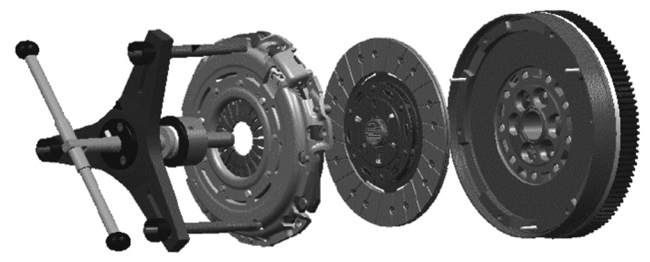Instructions for replacing the Central Clutch Slave Cylinder (CCSC)
Please read and follow all instructions carefully. You’ll find the same instructions in the brake caliper pack. Remember to keep them for the entire product life cycle. Hand them over to the new owner if you sell your vehicle.
We recommend you only perform those steps required for replacing the spare part or parts desired.
We recommend you only perform those steps required for replacing the spare part or parts desired.
Fitting procedure/Initial recommendations
1. Do not depress the pedal several times in succession when bleeding; depress just once and wait for hydraulic system to stabilise (risk of over pressure inside the CCSC)
2. Do not use any lubricants or cleaning agents as they may damage the seals in the CCSC.
3. Always keep an eye on the level of cleanliness.
4. Only use brake fluid approved by the vehicle manufacturer.
5. Clean old seals or remove them (if supplied with the CCSC) and wipe dust off the connection surface.
6. Clean the tip of the transmission shaft and make sure the sealing surface is not too worn.
7. Make sure the CCSC is installed flat against the transmission-mounting surface.
8. Make sure the adaptor is engaged before fully tightening the fastening screws on the CCSC.
9. Position the device fixing bolts and tighten according to the vehicle manufacturer requirements.
10. Never bleed the CCSC if the clutch and flywheel have not been fitted yet (reaction load to CCSC).
11. Make sure the CCSC is not inclined during installation, as this may lead to damage at the lugs or reduced service life (angular misalignment).
12. At the end of the bleeding process, re-tighten the screw (where present) to ensure its seal.
Always replace the clutch mechanism for clutch actuation with wear recovery. Always replace the clutch flywheel and the diaphragm.

Correct fitting procedure
The method of mounting the lid on the flywheel has a major impact on the functional characteristics of the clutch system – specially for the self-adjusting clutches - and thus on CCSC performance and service life (load/height).
In order to comply and maintain compliance of the clutch system with respect to these characteristics, fit the clutch using a specific tool before inserting the flywheel. See the diagram below.
When fitting the clutch system, take the utmost care to avoid possible errors which may occur and thus damage the CCSC, thereby nullifying the manufacturer’s warranty.
Below are some of these:
1. Assembly error - flywheel opposite side
The flywheel assembled incorrectly (opposite site) will damage the CCSC causing deformation of the retaining ring and leaking.
2. Assembly error - over stroke
In the event of an error in assembling or bleeding, the CCSC system could work in over stroke. An excess stroke will result in the damaging of the retaining ring or of the primary seal as the ring may slip off the guide.
3. Axial and angular shaft/engine misalignment
An error in axial and/or angular assembly of the CCSC referring to the gear shaft could lead to its reduced functional and service life, reducing the life of the shaft seal on the gearbox side.
4. Fluid not correct
The clutch hydraulic system must only be filled with brake fluid. Never use mineral oil and always use the fluid recommended by the manufacturer in the vehicle owner manual.
5. Bleeding error – over pressure
Manual bleeding should be carried out using the following process:
- Depress the clutch pedal.
- Open the bleed valve
- Keep the clutch pedal depressed until fluid appears – Do not release!
- Close the bleed valve
- Slowly release the clutch pedal
6. Brake fluid / clutch system / cleaning the CCSC
Contamination may cause sporadic leaks when dirt particles accumulate under the sealing lip and may also cause permanent leaks when the lip seal swells upon contact with incompatible substances.
7. Contamination – gear shaft
Contamination on the shaft due to disassembly or re-assembly operations may cause sporadic leaks when dirt particles accumulate under the sealing lip of the gear side shaft seal or on the hub seat sealing o-ring. This may also cause permanent leaks when the seal lip swells.
General and safety information
This Brembo product has been designed to comply with all applicable safety standards. Products are not intended to be used differently from the specific use for which they have been designed and manufactured. Use for any other purpose, or any modification to or tampering with the Product can affect the performance of the Product and may render the Product unsafe.
Such modification or improper use will void the Limited Warranty, and may subject the individual so using the Product to liability for bodily injury or property damage to others.
Such modification or improper use will void the Limited Warranty, and may subject the individual so using the Product to liability for bodily injury or property damage to others.
In these instructions, the “DANGER!” warning means procedures which, if not observed, have a high degree of probability that they will cause serious injury or even death. “CAUTION” means procedures which, if not observed, could result in physical damage whereas “WARNING!” means procedures which, if not observed, could possibly cause damage to the vehicle.
DANGER! Before commencing replacement, ascertain that the spare parts are suitable for the make and model of the vehicle. This Product is vital to the safe operation of the vehicle on which it is installed, and it is intended to be installed only by a skilled, qualified individual who has been trained and/or is experienced in the installation and use for which the Product is intended.
The installer must be equipped with the proper tools of his trade, and with the knowledge and experience to deal with vehicle repairs. Improper or incorrect installation, whether caused by a failure to follow these Instructions faithfully and completely or otherwise, will void the Limited Warranty and could subject the installer to liability in the event of personal injury or property damage.
The worn parts replaced by this Product must not be installed on any other product. This could result in property damage and personal injury, including death.
Avoid contact of grease and other lubricants with the braking surfaces of the disc and pads as this could affect the efficiency of the braking system.
Always check that the brake fluid level in the reservoir is between the minimum and maximum levels indicated on the reservoir. An incorrect level can cause brake fluid leaks or reduced braking system efficiency. Too much or too little brake fluid in the reservoir could cause the brakes not to perform properly resulting in personal injury, including death.
Brembo shall not be liable for any damage or injury caused to or by any person operating a vehicle on which a replacement product has been improperly installed.
CAUTION! Replaced parts must be disposed of in accordance with the law.
It is vital to avoid sharply striking and/or damaging the Product, its parts and its components, as this can impair their efficiency and may cause them to malfunction. If necessary, replace any damaged part or component. To avoid injury we recommend the following:
It is vital to avoid sharply striking and/or damaging the Product, its parts and its components, as this can impair their efficiency and may cause them to malfunction. If necessary, replace any damaged part or component. To avoid injury we recommend the following:
- Use suitable equipment to prevent the inhalation of dust raised during cleaning of the parts.
- Always wear gloves during disassembly and assembly of components with sharp edges.
- Do not allow skin surface to make direct contact with the friction material of pads and brake shoes since this could cause abrasions.
- Do not introduce your hands in the seat of the pads when removing the caliper pistons using compressed air as this involves the risk of crushing your hands.
- Avoid direct contact with the brake fluid as it can cause irritation to the skin and eyes. In the event of accidental contact, clean thoroughly in accordance with the vehicle or brake fluid manufacturer’s instructions.
- Do not subject the electrical components to electrostatic charges or to impact which could damage the plastic parts.
- Protect the disassembled electrical components from humidity.
- Ensure correct connection of any electrical contacts, checking that the warning lights come on. If they do not, non-operation of the warning lights can cause a reduction in efficiency of the braking system, or brake signalling failure.
WARNING!
- Do not use sharp tools to fit rubber components as this could damage them. Make sure any damaged parts are replaced.
Ábyrgðartakmarkanir
Þessi ábyrgð nær yfir allra samræmisgalla sem koma fram innan tveggja ára frá því að varan er afhent. Neytanda er skylt að tilkynna söluaðila um samræmisgalla innan tveggja mánaða frá því að umræddur galli kom í ljós, með fyrirvara um að fyrningarfrestur til að grípa til aðgerða til að bæta úr gallanum er tuttugu og sex mánuðir frá því að varan er afhent. Ef um samræmisgalla er að ræða á notandi rétt á viðgerð eða endurnýjun vörunnar, eða á viðeigandi verðlækkun eða uppsögn samnings, eins og kveðið er á um í gr. 130 í neytendalögum, eftir því sem við á.Þessi ábyrgð er eina ábyrgðin sem veitt er í tengslum við þessa vöru og kemur í stað hvers kyns annarra ábyrgða, hvort sem þær eru munnlegar eða skriflegar.
Er eitthvað annað sem þú vildir spyrja um?
Hafa samband við tækniaðstoð Brembo. Tæknimenn okkar munu hafa samband við þig eins fljótt og auðið er!






